« LAC Health Stats, Trends and Trivia | Home | Improving Paraguay’s Environmental Management »
State of the North American Environment
By Keith R | June 21, 2008
Topics: Environmental Protection | No Comments »
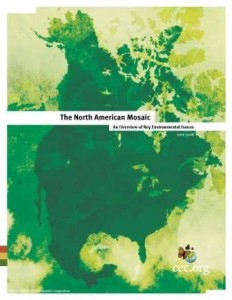 The North American Commission on Environmental Cooperation (CEC) has just released a “state of the environment” (SOE) report entitled The North American Mosiac (English, Spanish, French). The CEC is the main vehicle for environmental cooperation between Canada, Mexico and the US, and as I stated in a prior post, like it or not, Mexico has tied its environmental policymaking to that of its two NAFTA partners.
The North American Commission on Environmental Cooperation (CEC) has just released a “state of the environment” (SOE) report entitled The North American Mosiac (English, Spanish, French). The CEC is the main vehicle for environmental cooperation between Canada, Mexico and the US, and as I stated in a prior post, like it or not, Mexico has tied its environmental policymaking to that of its two NAFTA partners.
The last time the CEC issued a SOE was in 2002. The report will provide context to the next meeting of the Environment Ministers from the three nations, as well as the one-day conference next week on the future environmental agenda for the CEC.
The report is only an overview, identifying key trends, issues and data gaps, but a useful “big picture” snapshot nonetheless. 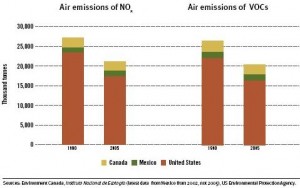 It is organized into four major sections:
It is organized into four major sections:
Air and Atmosphere
Climate Change
Ground-level Ozone
Particulate Matter
Stratospheric Ozone
Biodiversity and Ecosystems
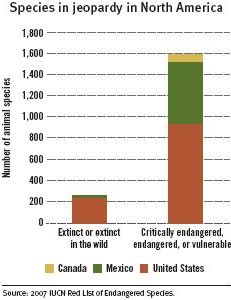 Land Use
Land Use
Oceans and Coasts
Invasive Species
Species of Common Conservation Concern
Pollutants
Acid Deposition
Industrial Pollution and Waste
Persistent Bioaccumulative Toxic Substances
Water
Water Quality
Water Quantity and Use
Shared Water Resources
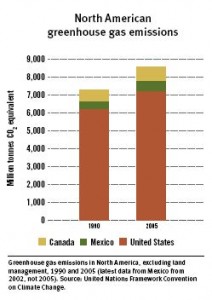 The report, like many CEC documents, is a bit measured and circumspect — no startling admissions or revelations here. Some of the points it makes:
The report, like many CEC documents, is a bit measured and circumspect — no startling admissions or revelations here. Some of the points it makes:
- In North America, the largest source of greenhouse gas (GHG) emissions is energy-related activities, including electric power generation, transportation and industrial fuel use. Some of these emissions are offset by factors such as forest and agricultural carbon sinks. North America is responsible for about a quarter of global GHG emissions. Since 1990, North American GHG emissions have increased by almost 18%, or at roughly the same rate as total energy use.
- Canada, Mexico and the United States have substantially reduced emissions of ozone-depleting substances (ODS) over the last 20 years, but these substances are still released from various sources in North America.
Compared with overall landscape modification since European colonization, current annual changes are small. However, rates of deforestation and urbanization in certain areas are affecting local ecological systems and global climate.
- Despite progress using ecosystem approaches to management and the precautionary approach, trends in North America show continuing overfishing in some areas and ongoing challenges related to land use change, habitat damage and bycatch. Climate change is expected to impose additional stress on marine and coastal ecosystems.
- Comprehensive biomonitoring data are not available for all of North America, but local and country-specific studies have measured persistent bioaccumulative toxic substances (PBT) levels in humans and wildlife. The implications of these findings are under investigation in all three countries.
- Although freshwater quality in many parts of North America is good, a significant portion of North American surface freshwater is degraded. A similar assessment of groundwater is not possible, but in certain areas it is known to be degraded by nitrates, pesticides and salinity.
Conventional pollutant discharges from industrial point sources have largely fallen over the last 30 years in North America, but nonpoint and diffuse pollutant sources such as agricultural runoff, stormwater runoff and atmospheric deposition have become relatively larger contributors to impairment of water quality.
- Total water withdrawals have increased in all three countries. Climate change, population growth and changing patterns of development likely will heighten competition among water users.
________________________
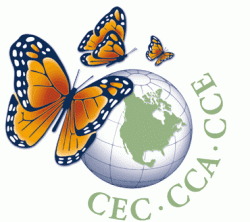 From the North American Commission on Environmental Cooperation (CEC):
From the North American Commission on Environmental Cooperation (CEC):
New report looks at the state of the North American environment
Fourteen key issues reviewed to identify challenges and opportunities for environmental cooperation in the NAFTA nations
In its latest state of the environment report, released today, the Commission for Environmental Cooperation (CEC) examines environmental issues facing the NAFTA partners.
The report addresses issues related to air and atmosphere, biodiversity and ecosystems, pollutants, and water. Specific topics include climate change, species of concern—including the critically endangered vaquita porpoise—and the quality and quantity of water shared between the North American nations.
The North American Mosaic: An Overview of Key Environmental Issues is a follow-up to the CEC’s 2002 state of the environment report and responds to the CEC Secretariat’s obligation to periodically address environmental conditions in Canada, Mexico and the United States. With the advice of environmental reporting experts from the three countries, the report draws on information from national and international sources for a broad overview of North America’s environment.
Today, this report was presented to the environment ministers of Canada, Mexico and the United States in advance of their annual meeting, to be held in Ottawa, Canada, on 26 June.
“Over the next year, we will use this report, along with other important information, to engage the public, subject matter experts and governments in evaluating our progress to date and future opportunities for cooperation,” said CEC Executive Director Adrián Vázquez-Gálvez.
“It will help us identify the central environmental challenges confronting North America, as well as the top priorities for cooperative action among the three countries to address these environmental challenges.”
________________________
Desde la Comisión Norteamericana para la Cooperación Ambiental (CCA):
Nuevo informe sobre el estado del medio ambiente en América del Norte
Se examinan catorce temas fundamentales a fin de identificar retos y oportunidades para la cooperación ambiental entre las naciones del TLCAN
En su más reciente informe sobre el estado del medio ambiente, dado a conocer el día de hoy, la Comisión para la Cooperación Ambiental (CCA) examina la problemática ambiental que los socios del TLCAN enfrentan.
En este informe se abordan temas relativos al aire y la atmósfera, la biodiversidad y los ecosistemas, los contaminantes y el agua. Entre los temas específicos figuran el cambio climático, especies de preocupación —entre otras, la vaquita marina, en peligro crítico de extinción— y la calidad y cantidad del agua compartida por las naciones de América del Norte.
El mosaico de América del Norte: panorama de los problemas ambientales más relevantes da seguimiento al informe de la CCA sobre el estado del medio ambiente correspondiente a 2002 y responde a la obligación de la Comisión de abordar periódicamente las condiciones ambientales en Canadá, Estados Unidos y México. Con la asesoría de expertos en la elaboración de informes ambientales de los tres países, este documento se basa en fuentes de información nacionales e internacionales a fin de ofrecer un amplio panorama del medio ambiente en América del Norte.
El día de hoy se presentó el informe a los ministros federales de medio ambiente, o equivalentes, de Canadá, Estados Unidos y México con anticipación a su reunión anual, que se realizará en Ottawa, Canadá, el próximo 26 de junio.
“A lo largo del año siguiente usaremos este informe, junto con otra información relevante, para que la ciudadanía, expertos en la materia y organismos gubernamentales participen en la evaluación de nuestros avances a la fecha y de futuras oportunidades de cooperación”, señaló el director ejecutivo de la CCA, Felipe Adrián Vázquez Gálvez.
“Nos ayudará a identificar los retos ambientales centrales a los que se enfrenta América del Norte, así como las principales prioridades para la acción conjunta entre los tres países a fin de atender tales desafíos.”
Tags: agricultural runoff, air pollution, atmospheric deposition, cambio climático, Canada, carbon sink, CCA, CEC, Climate Change, coastal ecosystems, deforestación, deforestation, diffuse pollutant sources, ecosystem management, environment, Estados Unidos, EUA, freshwater quality, gases de efecto invernadero, greenhouse gases, marine ecosystems, medio ambiente, Mexico, NAFTA, nitrates, nonpoint sources, North America, overfishing, ozone depleting substances, particulate matter, PBT, persistent bioaccumulative toxic substances, pesticides, plaguicidas, power generation, precautionary principle, stormwater runoff, sustancias peligrosas, TLCAN, transportation, urbanization, USA, water withdrawals


